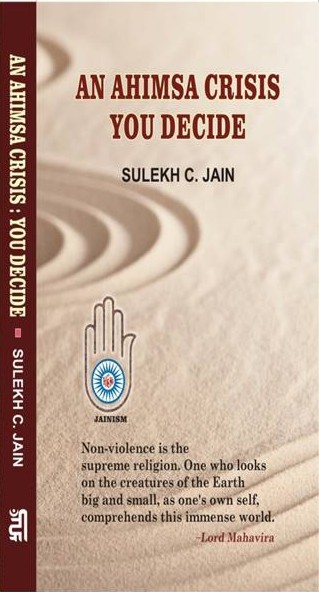Amongst a total Jain population of nearly 5-7 million, we have more than 15,000 renunciates (muniis, acharyas, sadhus, sadhvis, samans, samanis, ailak, kshullaks, aryika ji, and pundits) in all the traditions, sects, and sub-sects of Jainism. Compared to any other non-Jain religious tradition in India, Jain sadhus are well-educated, they observe the five mahavratas (great vows), most of them practice what they preach, they command a very high degree of respect and reverence within the Jain community, are always on the move (they travel the length and breadth of India on foot), are in constant touch with their followers, and since the Jain community provides food, shelter and clothing, the sadhus do not have to worry about any such basic needs. Their main duty and goal is to study, practice self-purification, and to guide and preach to their followers about Jain philosophy and its rich culture.
Similarly, the Jain community (lay people) is very educated, affluent, dynamic, progressive, and philanthropically minded. Since there is no GOD or creator in Jainism, there are hardly any major fights and disputes on that basis within the community. As a result, the community enjoys a reasonable level of harmony, peace, and prosperity.
In spite of this, the sad reality is that Jainism is the least known and most misunderstood tradition, not only outside India but within India as well. In addition, the practice of ahimsa is slipping so fast within the community that Jains are in danger of losing ahimsa as its identifier. Let me share a few incidents to illustrate the depth of this malaise.
If one looks at Google, Amazon.com and other internet search engines, one will find hardly one thousand books on Jainism as opposed to probably a million on Buddhism. If this is the case, how will people know about Jainism?
What some authors (especially from the West) write about Jainism, the viewpoints are distorted, wrong, and sometimes just slanderous. Once this happens - and it happens every day - then the misperception is repeated and perpetuated and this is what people come to believe.
The general perception is that Jains live an unreachable life of other-worldliness, practice self-mortification, and do not contribute much to the welfare of the society. As a result, Jainism is not relevant in today’s environment.
When one looks at the Jain literature today, most of it deals with the lifestyles of sadhus and kings but very little is said of the householders. So the perception grows that Jainism is only about other-worldliness. The further pity is that one will find only a few books about ahimsa and its practice within the community.
Dr. Michael Tobias produced a one-hour long video on ahimsa, and also wrote a book entitled Life Force of Jainism, in which he deals with the practice of ahimsa. Jains in general have shied away from such projects.
Prof. Jeffrey Long at Elizabethtown College, Pennsylvania, who has been teaching world religions for a long time, observed that only a very few of his graduate or undergraduate students were actually interested in the study of Jainism. Prof. Long discovered that most of the students he encountered were turned off by Jainism because it seems unrelated to the real world, and it generally teaches only about other-worldliness.
Similarly, in a graduate class of world religions at the University of Hawaii, Prof. Cromwell Crawford asked his students what they knew about Jainism. The responses he got included, “Jains are those who make the biggest nudist colony in the world.” Another response was “Jains are those who wrap themselves with white bed sheets, with cloth masks on their faces and brooms in their hands and clean the streets of India.” If these accounts do not bring one pain, what will?
The Jain community has abdicated many of their duties and responsibilities to respond to the constant changes facing the community, and to help shape it.
Jain sadhus and sadhavis, with their lifestyle of austerity, their vow of five Mahavaratas, and their scholarly knowledge of Jain agamas, provide a great service to the community in terms of imparting knowledge and keeping the Jain community and traditions alive. But Jain sadhus, because of the limitations of their code of conduct, cannot be expected to be experts in all aspects of the day to day practice of ahimsa as they themselves don’t experience the daily challenges and pressures of householders’ lives.
For example, sadhus cannot be experts about professions such as business, accounting, law, engineering, medicine, new and developing technologies, the ecology and environment, sustainability, public administration, police, military, trade, investing, accounting, and on issues such as abortion, end of life situations and decisions, and bioethics. Just a simple talk or discourse on the basics of ahimsa is not enough to help ordinary people find suitable and practical answers for day-to- day practitioners of such professions.
Even if some sadhus are dynamic and social reformers, they too often shy away from discussing such topics in public. Most are content in delivering the daily or weekly pravachan purely as a ritual and that too is only given on non-ahimsak topics.
The Jain community likes to attend lectures that are entertaining rather than perceptive, critical, visionary, and rational. In general, they (householders) also lack the interest and patience for discussing and hearing such lectures about ahimsa.
During the last few years, I sought to organize Ahimsa Vichaar Manch (ahimsa discussion forums) and seminars on ahimsa. I called several Jain centers in North America hoping to build programs. I am sorry to say, I found no interest at all. At one place, I was lucky to get it started but after just two sessions, it had to be cancelled due to lack of interest. Instead, the popularity, frequency, and intensity of poojas, rituals, and money collections are increasing; many times individual interest in these is directly proportional to the level of affluence in the community.
I have mentioned before - a Jain sadhu/muni has tremendous influence on a householder. Because of this inherent power that a sadhu/muni has, he can be a very powerful instrument for change, especially in teaching the community about ahimsa. Unfortunately, they too miss the boat most of the time.
Let me share an incident that illustrates this. About ten years ago, I had gone to the city of Indore in India. This city, with a sizeable Jain population, has the unique distinction of being a prominent center of Jain culture. At that time, a few Jain Digambar Munis were staying there. One day, I went to observe the ahar (food) giving tradition by the Jain community to a few of these munis.
As is the custom with the Digambar munis, they take food only once every twenty-four hours, before noon only. In practice, several devotees prepare the prescribed food and request the munis to accept their food. The muni generally has taken a small vow or a pre-condition (known only to the muni), and if that condition is met, he agrees to take food from that devotee.
After observing all this, I saw the muni-ji agreeing to accept the food from one householder only. Now, before he began eating, he asked the devotees (in this case, a Jain couple) to accept and take certain vows; once that happens, then and then only would the muni-ji start taking the food.
I watched this scene with a strong interest, as I wanted to know what kinds of vows muni-ji was asking his devotees to take. To my surprise, I noticed that the muni-ji asked his devotes to take vows to refrain from eating after sunset and also to avoid certain kinds of pickles during certain times of the year. Please note - all of this relates to Thali ahimsa only.
In the afternoon, I went to meet with the same muni-ji in private at the place where he was staying. Here I said to him, “Respected muni-ji, you command a great deal of respect and a spiritual power within the Jain community. You have the power to shape the community. Today, I was surprised that you did not use that power effectively. Instead of asking your devotees to take vow of not eating after sunset and certain kinds of pickles, you could have asked them not to use and deal in animal-based products like silk, leather, wool, pearls, and silver foils and to abstain from all kinds of adulterations in food.” To this he had no answers and he basically ignored me.
We talk of veganism and cruelty-free products. And yet, one will be hard pressed to find even a dozen sadhus who do not use dairy products such as milk and milk products. In my opinion, either they don’t believe that there is himsa in milk production or they don’t want to know about it. Three years ago, during my trip to India, I was giving a talk about Ahimsa at a Jain institution and talked about himsa in the production of milk. After the seminar, I was told very plainly by a Jain sadhu not to talk about milk here. Imagine if sadhus become vegan (abstain from dairy products), how big a change that will bring within the Jain community. I am of the opinion that once you start giving up with dairy products, slowly the community will listen to other issues affecting ahimsa.
Many Jains currently display both a lack of understanding of Jain philosophy and pride in being Jain. This strange combination creates the mindset of “everything goes,” and the false belief that all choices are equally okay and acceptable.
Additionally, many religious speakers are either ignorant themselves or do not want to talk about anything beyond the most basic issues. They say only those things that will please their listeners and financial contributors.
What used to distinguish Jains from the majority is very quickly disappearing; a time is approaching when Jains will be no different than the rest in terms of their behaviors and lifestyle.
An Ahimsa Crisis: You Decide: Our Community Has Many Sadhus And Sadhvis, And Still Jainism Is Nearly Unknown
Author:
 Dr. Sulekh Chand Jain
Dr. Sulekh Chand Jain
 Dr. Sulekh Chand Jain
Dr. Sulekh Chand Jain
Published: 06.09.2016
Sources
 Title: An Ahimsa Crisis You Decide
Title: An Ahimsa Crisis You DecideAuthor: Sulekh C. Jain
Edition: 2016, 1st edition
Publisher: Prakrit Bharati Academy, Jaipur, India
Page glossary
Some texts contain footnotes and glossary entries. To distinguish between them, the links have different colors.
Page statistics
This page has been viewed 1070 times.